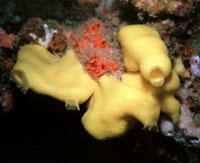Marine Biodiversity » Marine Sponges » Calcarea » Calcarea Classification
|
|||||
|
|
||||||||||||||||||||
|
REVIEWS: Dendy & Row (1913), Hartman (1958), Burton (1963), Borojevic (1966, 1968, 1977), Vacelet (1970, 1981, 1991), Borojevic & Boury-Esnault (1986), Borojevic, Boury-Esnault & Vacelet (1990). Borojevic, Boury -Esnault & Vacelet (2000). |
||||
|
taken from 'Sponguide' by J.N.A. Hooper (Queensland Museum, Brisbane) |
||||
|
|
||||
|
Supra-specific classification of Class Calcaronea has recently been revised in Hooper JNA & Van Soest RWM (2002): Systema Porifera. Guide to the Supraspecific Classification of Sponges and Spongiomorphs (Porifera). Plenum, New York, pp 1708, which contains some slight alterations to the one presented here from the Sponguide. |
||||
|
Due to copyright restrictions I am not able to reproduce those chapters here. Contact your local library or librarian. |
||||
|
An online version of the Systema Porifera is planned for the future. |
||||
|
However, classification of Calcarea in the Systema Porifera is not based on a thorough phylogenetic analysis and will certainly change in the near future. Therefore, the slightly older classification from the "Sponguide" provides an as good insight into these fascinating animals. |
